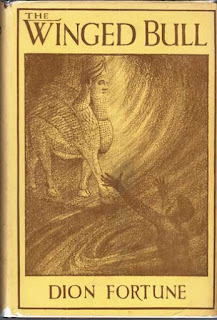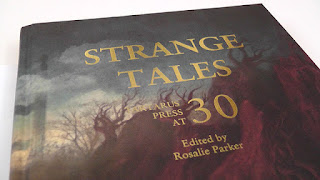In the opening of The Chain of Ob (Andrew Melrose,
1913) by St Clair Harnett, two Chelsea bohemians travel to a remote Cornish
ruin one of them has inherited, a cobweb-hung hall with creaking doors,
mildewed furnishings and vast shadows. The farmer who takes them there through
narrow lanes as dusk approaches admits that “they do say as how” it is haunted,
and is anxious to be away. This is the sort of beginning to a supernatural yarn
that I really relish, and things continue to be splendidly rustling and creepy.
They are told by a nearby cottage goodwife: “There’s a very wicked woman in
that ‘ouse!”. This irresistibly makes you picture Leslie Phillips stroking his toothbrush moustache and murmuring, 'Ding dong!' in suave tones, but it's not quite that kind of book. It emerges the place is reputed to be haunted by the ghost of
a witch. The pair discover a portrait which one of them, a connoisseur,
recognises as by the 17th century court painter Peter Lely. It depicts “a
female form in shimmering satins stood before a sylvan scene of rocks and
greenery.” The face is haunting. “Was there,” asks our hero, “some link between
those painted eyes, those canvas lips, and that strange sympathy that floated
round me in the darkness of this house?”
Reader, there was, and before you know it the narrator has time-slipped into
the 17th century and encounters this beautiful witch. Here he learns that
“there are divers souls that are ever subjected to unseen powers. When they are
born they bear a badge upon their persons, the Chain of Ob.” He too bears the
symbol. He continues to cross over between his contemporary time and the era of
his spectral lover, as they both try to avoid the baleful influence of the mark
upon them.
There was in the interwar period a cluster of enjoyable novels about timeslips,
such as Fanfaronade (1934) by Ivo Pakenham and Lovers’ Meeting
(1940) by Eleanor Smith. But The Chain of Ob seems to be a quite early
example, and is very satisfyingly full-blooded. You have the sense the author
was enjoying it to the full and this engages the reader. In some ways, in both
its theme and its somewhat artless style, the novel is quite like Lord
Kilmarnock’s Ferelith (1903).
Air Commodore Edward St Clair Harnett (b. 1881) served in the RAF in Iraq in
WW1 where he knew Gertrude Bell: he wrote an article, "Gertrude Bell and
the Iraq Museum" in Views and Reviews, Vol.22 No.3, 1927-1928, In
civilian life he was a barrister who wrote, under his full name, A Handbook
on the Law of Mortgages (1909): we are reminded that Bram Stoker was also
the author of a legal textbook.
An earlier novel, Rusted Hinges, A Novel On a New Plan (Andrew Melrose, 1912), is also about lives connected across time (that is apparently the ‘new plan' element of it). A third and apparently final novel under his name, The House of a Thousand Lamps (Selwyn & Blount, 1927), is set in Baghdad and seems to have mystical elements.
Harnett's first wife, Dorothy Grace Harnett (b. Co. Cavan, ca.
1891) wrote as “D. G. Waring” a series of eight novels in the 1930s, giving
rise to the suspicion (I forget where I read this) that she may have written
her husband’s books too. She served in the Red Cross during the First World War
and they married on 15 April 1916. But in fact St Clair Harnett’s first two
novels were published a few years before they were married, and presumably
written even earlier, when she was 21 or younger: so while still possible, this
does not seem likely. They might, of course, have collaborated in some way.
The couple had one son, Denis Henry Waring (1917–1964), but the marriage ended
some years later, and in 1927 St Clair Harnett remarried. He donated to
Birmingham City Museum forty two Near Eastern seals collected in Baghdad and
died c.1964-5 at the age of 83.
An unusual dimension to his career is that Harnett filed a patent application on 21 July 1910 for a board game based on horse-racing, which he described as follows:
“A race game, which may be used for advertising, is played with model horses which are moved over a board (a), divided into a number of spaces (d) representing the course, two or more spaces (y), (h), and other spaces (i) marked with the odds against the pieces in use. The names of the pieces are shown in spaces (m), and other spaces (n) may be provided for the reception of the cards to be dealt to each piece.
The number of spaces (d) over which each piece has to travel to reach the winning post varies with the odds against the piece. In playing the game, a player stakes counters on a piece, and each piece has a card dealt to it by the banker. The piece that receives the highest card is moved forward one space, and another hand of cards is dealt. The banker pays out counters to those players who have selected the winning pieces and colour according to the odds marked on the board. Portions of the front and back of the board may be utilized for advertising purposes.”
Although a variety of horse racing games involving cards or dice have been marketed, there does not seem to be one exactly like Harnett’s game. Clearly it is time for some enthusiastic amateurs to do a mock-up of the board and play the game for the first time, no doubt, in over a hundred years. Who knows whether as the cards fall and the toy horses move, there might be a queer flicker and the players will find themselves in evening dress, smoking Sullivans over a green baize table in that last Edwardian summer?
(Mark Valentine)






















